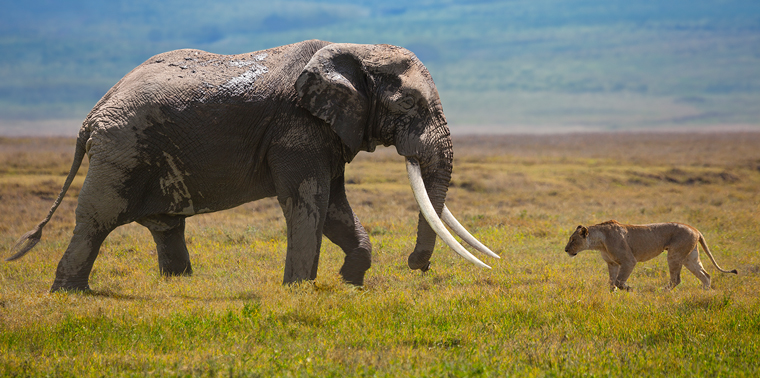October 4, 2018 — Editor’s note: This essay was condensed from Poached: Inside the Dark World of Wildlife Trafficking, released in September by Da Capo Press.
Wildlife protection is rarely as dramatic as an ivory bonfire. Instead, much takes place in the soulless conference rooms of CITES, the Convention on International Trade in Endangered Species of Wild Fauna and Flora. This binding treaty among governments was created “for the protection of certain species of wild fauna and flora against over-exploitation through international trade.”
The message sounds pretty straightforward, but dig a bit deeper and CITES quickly becomes confusing. What are the different levels of protection? Who exactly sets species listings and policy recommendations — and how? And what, if anything, happens if countries drop the ball on their commitments?
Far From Perfect
CITES dates back to 1963, when attendees at an International Union for Conservation of Nature meeting realized that unregulated trade directly threatened certain species — yet the world had no way to control it. A treaty was drafted and signed, and in 1975, CITES went into force. The convention now includes 183 governments, and its listings have grown to some 35,000 species. Countries register around a million transactions per year, which range from a single specimen to hundreds or thousands.

International trade of the emerald tree boa, native to South America, is regulated under CITES Appendix II. Photo © iStockphoto.com | Stuartb
To ensure those trades are sustainable, CITES categorizes species under appendixes. Appendix I is reserved for plants and animals threatened with extinction. Appendix I species can’t be traded for primarily commercial purposes, save for a few exemptions. Appendix II species are those that are not deemed threatened with extinction, but — should they be freely traded — may enter the danger zone. Unlike Appendix I species, they require only an export permit and can be traded internationally for commercial purposes.
Decisions to “uplist” or “downlist” species to and from various appendix listings, or to add a new species or remove an existing one, are made at the CITES meetings of the Conference of the Parties. Proposals require a two-thirds majority vote to pass and are supposed to be science based, taking into account evidence such as how many of the animals are left in the wild; how urgent the threats are to their survival; and how many, if any, can be removed sustainably.
For many species, experts lack even the most basic data, including population estimates, making it impossible to know what levels of trade are in fact sustainable.The process is far from perfect. For many species, experts lack even the most basic data, including population estimates, making it impossible to know what levels of trade are in fact sustainable.
“It is funny in a sick kind of way that we, on the one hand, agree to regulate the trade in these vulnerable species, but then we accept that for the majority of them, we have no clue what sustainable levels of offtake are,” said Vincent Nijman, a conservation ecologist at Oxford Brookes University. “A logical next step would be to agree, then, that if we have no idea what we can take, we should minimize international trade. But instead we continue with a business-as-usual scenario, trading until we can clearly see that we have gone too far.”
Staggering Scale
The scale of the trade is staggering: from 2006 to 2015, 1.3 million live animals and plants, 1.5 million skins, and 2,000 tons of meat were legally exported from Africa to Asia alone, according to a 2018 TRAFFIC study. Yet that example pertains only to CITES-listed species. In fact, a minority of plants and animals are so lucky as even to be included under the treaty. The volume of international trade in animals not categorized by CITES is about 10 times greater than the trade in listed ones, Nijman said, while the domestic trade is 10 times greater than that.
Look a bit closer at legal trade, however, and it begins to appear more and more illegal. For starters, legally binding rules are broken with impunity, including ones that govern harvesting quotas and capture methods, dictate who can sell what where, regulate transport, and stipulate required licenses. Not surprisingly, very few people pay their taxes on wildlife goods trafficked through the system, so many are also guilty of tax evasion.
“Once you have broken those rules and regulations, it makes it difficult to continue without bribing your way through the system,” Nijman said. “Taking this view, then the majority of the wildlife trade in Asia, and probably elsewhere, is illegal.”

Regulated under CITES Appendix I, the ring-tailed lemur is among the world’s most endangered primates. Photo © iStockphoto.com | seewhatmitchsee
For now, though, the legal-just-kidding-not-legal side of the trade remains widely accepted. Like jaywalking in New York City or driving 5 to 10 miles per hour over the speed limit, shady wildlife businesses have operated openly in this manner for such a long time that they’ve become normalized.
“This kind of trade carries no stigma, and no one is prosecuted for it,” Nijman said. “It’s become legal, even if technically it isn’t.”
Amending the system is challenging, not the least because scientists and nongovernmental organizations can neither submit CITES proposals nor vote. The best they can do is lobby government representatives to do so. Government reps, however, also hear from those with commercial or personal interests, and they lobby each other to go along with particular agendas. Some countries unscrupulously trade votes, while others in effect buy votes. The effect, as Ronald Orenstein noted in Ivory, Horn and Blood, is that species listings becomes an ad hoc and highly political process.
Various individuals and organizations have complained for decades about this, with many alleging that some CITES employees and government representatives prioritize personal gain over species conservation.
“It’s like having the U.N. Refugee Agency without a focus on refugees, or UNICEF without caring about children.” – Annie Olivecrona“Watch what is going on outside the conference halls, with people having private meetings and doing deals on the side,” said Annie Olivecrona, a Kenya-based conservationist. “It happens all the time, and you can be sure it is not beneficial for wildlife. It’s like having the U.N. Refugee Agency without a focus on refugees, or UNICEF without caring about children. I think it’s high time to do a proper external audit of the Secretariat and see what they have actually achieved over the last 40 years.”
What started as a conservation treaty regulating trade, agreed conservationist and author Judith Mills in 2015, is “on the verge of becoming a trade treaty regulating conservation.”
People Problem
Chris Shepherd, executive director of Monitor , an organization working to reduce the impact of illegal and unsustainable wildlife trade, emphasized, though, that CITES has a people problem — not a treaty problem.
“There’s really not a lot that we need to do to improve CITES,” he said. “It just needs to be enforced.”
CITES’ power lies in the fact that it is binding international law. CITES’ power lies in the fact that it is binding international law. Even so, noncompliance is rampant. For starters, countries regularly fail to turn in data on the number of seizures or trades they undertake per year. In 2010, for example, China reported importing 130 ivory “carvings,” 40 elephant feet, 99 pounds of tusks, and zero trophies from Zimbabwe, all under the supposed label of legal “personal” items. Zimbabwe’s records of exports to China over the same period, however, told a completely different story: 2,512 ivory carvings, eight elephant feet, four trophies, and 41 tusks. When trade data are even entered into the database at all, such glaring inconsistencies are often the norm.
“Monitoring trade using data which is more or less gobbledegook is next to impossible,” wrote John Sellar, the now-retired former chief of enforcement at the CITES Secretariat.
Reporting issues, moreover, are the least of CITES’s worries. Some CITES representatives are negligent or abusive of the import-export system: they issue permits when they shouldn’t, sell permits, or allow permits to be “stolen” from their offices.
“Some countries will sell you a CITES permit for pretty much anything you want,” said Tim Steele, the U.N. Office on Drugs and Crime’s global anticorruption advisor, at a panel on corruption.
Other longtime member countries lack even proper legislation to carry out their duties to CITES.

The tawny owl is one of more than 1,300 bird species listed under CITES’ three appendices. Photo © iStockphoto.com/scooperdigital
“Everyone’s freaking out about tigers going extinct, but of course they’re going extinct if parties involved in the trade don’t even have laws to stop it,” Shepherd said. “Why not freak out instead about the CITES Secretariat not holding those countries accountable?”
Orenstein shares Shepherd’s frustration, but he also emphasized that some countries genuinely want and try to do better but lack the resources. In other cases, honest wildlife officers are impeded by officials. “CITES can of course do a lot better,” he said. “But to imply that it is entirely venal is an overstatement in the other direction.”
The S-Word
Holding countries accountable is tricky, as CITES has few real teeth to bite with. Sanctions, however, are one powerful tool it does possess. If a party to the convention is found guilty of enough violations, CITES can issue sanctions that — if respected by other nations — prevent that country from trading in CITES-listed species. Those species may include timber, orchids, seafood, pets, reptile skins or anything else included in the convention. For many nations, the economic repercussions of such sanctions would be significant.
When sanctions — or even a threat of sanctions — are issued, the results tend to be mixed. In 2013, CITES used the s-word to encourage Thailand to clean up its illegal ivory market — a move that did have the desired effect.
The amount of ivory in Bangkok’s markets dropped by 96 percent between 2014 and 2016, leading TRAFFIC to describe Thailand as “an outstanding example” of CITES propelling positive change.“Everyone knew that Thailand was the world’s largest unregulated illegal ivory market, but nothing was changing,” said Leigh Henry, a senior policy advisor at WWF. “It wasn’t until ‘sanction’ was put on a piece of paper that we started to see real progress.” Indeed, the amount of ivory in Bangkok’s markets dropped by 96 percent between 2014 and 2016, leading TRAFFIC to describe Thailand as “an outstanding example” of CITES propelling positive change.
Thailand, however, was an exception to the rule. Laos, in contrast, was briefly subjected to a trade ban after it failed to submit reports on its progress to combat illegal ivory trade. After the country scraped together an official National Ivory Action Plan to appease CITES, the ban was lifted never mind the fact that illegal ivory is still openly sold there, alongside a Peterson Field Guide’s worth of other protected species. In this case, the sanction did not have a meaningful effect—but at least it was issued.

Although CITES often brings to mind images of creatures with fur or tusks, it also regulates trade in plants, including this Akersia roseiflora cactus. Photo courtesy of Dornenwolf, from Wikimedia Commons, licensed under CC BY 2.0
In reality, sanctions are hardly ever passed, and they almost always gloss over bigger players in the illegal trade. As one source noted, it’s up to the CITES parties — not the Secretariat — to decide who should be sanctioned, and too many countries are too influenced by powerful nations such as China to ever consider issuing sanctions against them. Country representatives also tend to be highly political when it comes to enforcement: avoiding embarrassment for colleagues sometimes takes priority over enforcing the treaty. Or, as Orenstein noted, it may simply be that they’d rather not have the same finger pointed at them.
Because of such failings, some consider CITES impotent, not only in its ability to combat illegal trade but also in its basic role of regulating sustainable legal trade.
“The actual tool is excellent and could really make a difference,” Shepherd said. “But parties need to hold each other accountable if the convention is going to function.” The reality, though, is that “CITES seldom bites,” he continued. “And if CITES never bites, then what’s the point?”
Crawford Allan, senior director of TRAFFIC, agreed that the system can be frustrating but pointed out, “CITES, for all its flaws, is the best we’ve got.” ![]()
Ensia shares solutions-focused stories free of charge through our online magazine and partner media. That means audiences around the world have ready access to stories that can — and do — help them shape a better future. If you value our work, please show your support today.
Yes, I'll support Ensia!
